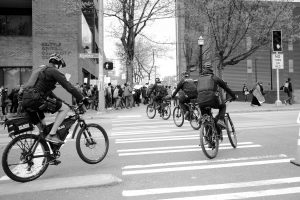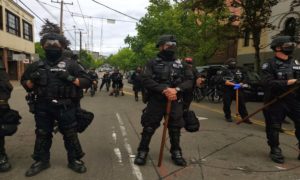The April 16th walkout to “[Re]invest in our colleges” at all Seattle Colleges institutions may be over, but for many their fight for funding has just begun.
At 8:30 am on Tuesday, April 16, Seattle Colleges walked out.

At Seattle Central College (SCC) it wasn’t massive, at least at first; many teachers had informed their classes that lessons were canceled because of the walkout, and so decent amount of students just didn’t show up that day. In bunches of three’s and five’s, with the occasional larger group from a whole class or an outside organization, protesters slowly congealed in Central’s South Plaza.
While the main portion of the walkout was scheduled from 11:30-12:30, speakers and events took place from 8:30 onwards. After an opening speech by SCC chemistry professor Dr. Erin Gibbons, a steady stream of faculty and students – both current and previous – spoke about their goals for the walkout and why they participated in it. On top of speakers, the American Federation of Teachers (AFT) had booths set up where picketers could snack on tangerines and muffins, write out posters, and text or email their legislators. At the top of every hour, AFT lead the full complement of protesters on a march around the block.

At 11:00 am the walkout’s attendance had grown to about 200 people, with more on the way to see the main event. Among the diverse group of protesters (including retirees taking classes to keep active, Running Start students just starting their college journeys, and students and teachers of everything from carpentry to communications), the reasons given for walking out were variations upon the same theme; Seattle Colleges no longer have the money to meet their needs – especially considering the high cost of living in Seattle. Anna Jacobs, a math professor at SCC of nearly 4 years, describes the needs for a budget increase as threefold; “it’s for students who need a good education, it’s for [the schools] who need to be able to attract and retain excellent teachers, and it’s for the faculty who need support.”
“The situation is dire,” adds English Professor Erin Steinke. “The cuts just keep coming [and] there’s no end in sight. … [The legislature needs to understand that] this isn’t just a line item in a budget; it’s people’s lives.”
“The situation is dire,” adds English Professor Erin Steinke.
By 11:30 — when the main speakers were scheduled to take the podium — the crowd had swelled to around 400 protesters. Among those giving speeches were Councilwoman Kshama Sawant, Seattle Colleges Chancellor Shouan Pan, and SCC President Sheila Edwards-Lange. For the following hour, these and other speakers each articulated Seattle Colleges’ demands for better funding. After these talks, protesters dispersed fairly rapidly, leaving only a handful of stalwart picketers.

Not all students could make the walkout — and not for lack of wanting. Many students, including Communication and Media Studies major Rick Beau, couldn’t make the walkout because of their professors; Beau wanted to participate in the walkout, but his instructor mandated class attendance on the 16th. Despite his inability to participate he still expressed his support, saying that “there is no reason why the teachers don’t have a living wage here, but if they were teaching at UW they would.”
A significant number of professors held class during the walkout (though not all mandated class attendance). Expressing views held by some of these faculty members, SCC Biology Professor Yool commented on a public Facebook post promoting the walkout: “During my classes. Going to be with my students, where I should be. Not leaving my commitment…”. The Collegian reached out to Yool, who declined to comment further.
Economics Professor James Hubert expressed similar sentiments in an in-person interview. He explained that he chose to teach class on the 16th because “I have an ethical and legal responsibility to the students and the college to be in my classroom at the appointed time,” he continued, saying that the goals of the walkout didn’t affect his decision one way or another since this responsibility was “quite simply” the only factor in his choice.

“I understand why the event took place… and have sympathy with the participants,” he added, but “they should talk to their legislators. They’re getting what they voted for.” He declined to further elaborate on exact policies or politicians, simply reiterating that “the legislature has spoken and voted. [If people don’t like it,] maybe they should reassess their voting.”
The dust has cleared in both the Washington State House and Senate and the two-year state budget has been approved. Appropriations bills, or the pieces of legislation that fund everything from special projects and infrastructure to state worker salaries, have to be approved by both the House and Senate and also must be signed by the governor. This budget will allocate funds across the state for the next two years, including for education.
CTC faculty salaries in WA are still 6.5% lower than those of peer states
Three main points about the appropriations bill directly affect Seattle Central. The State Need Grant, a tuition fund for students whose household income is less than 70% of the state’s median family income, was fully funded. The issue of faculty compensation was a major point in the ROC campaign: the coming budget, which falls under the July 2019 and July 2020 fiscal years, includes a pay rate increase of 3.2% and 2.8% respectively for faculty and technical college classified employees, leaving them with a general salary raise of 6% over the 2 years. According to a study by Western Washington University, “Washington State Community and Technical Colleges: Faculty and Administrator Salary,” this still leaves salaries 6.5% lower than those of peer states (states that regionally and demographically resemble Washington).
We spoke with Chris Conley, the AFT Faculty Senate President of Seattle Central, after the walkout but before the budget was sent to Governor Inslee’s office for approval. His concerns around legislative response relayed a previous grievance of the state not fully understanding the dire situation the CTCs are facing. “I would hope that after this action the legislature would recognize the crisis and fully fund the initial ROC request of $500 million for the Community and Technical College system,” he said in an email interview days after the walkout. He also expressed skepticism that the demands of the Reinvest in Our Colleges campaign were being given the weight they deserved. “What we might get is what they already proposed plus a few percentages, like 3 or 5% after seeing us,” he concluded.

The question of who pays for those salary adjustments has been a deep point of contention when budgeting for Seattle Colleges. Historically, the COLAs or Cost of Living Adjustments are funded 65% by the state, and the remaining 35% falls on the school itself to raise. This has traditionally left Seattle Central with a 2 million dollar deficit. This year, in a total policy turn around, the state will be funding 100% of the COLA salary increases. This will greatly relieve the Seattle Colleges of some of their financial burden. And finally, there were major investments into nursing degree and STEM programs, both currently in-demand fields. The money for these programs comes from the state and must be used for that explicit purpose.
During the walkout, students gathered signatures “to call on the school and state to find another source of funding that doesn’t hurt the school, instructors, or us”. The petitioners are attempting to build a student group to address tuition hikes and other issues directly affecting the student body. These demands were not met; students attending Seattle Central in the fall will likely find a 2.4% increase in tuition from this current academic year. The budget bill allowed for a statewide tuition increase up to and not more than 2.4%, but does not require it. The districts themselves are allowed to increase tuition up to this point. In a May 2 meeting on the 2019-2020 budget for Seattle Colleges, it was announced that the Seattle Colleges District would 1% of that tuition increase, leaving 1.4% behind for the colleges.

Some have heralded the most recent legislative round as a success. In an email to faculty, Annette Stoffer, District President of AFT local 1789 said, “We can take a moment to celebrate and congratulate each other on an impressive job. Our unified message, delivered by students, college employees, and community supporters, was hard to ignore!” Looking at participation in the April 16th Walkout compared to years past, which netted barely 100 attendees, Stoffer’s comments are hard to argue with. But even as congratulations are due, cuts are still looming across the campus. Each unit of the college — instruction, student services, admin services, and president’s office — have been asked to model a 3% budget reduction. In other words, they are being asked to come up with a plan that accounts for each unit operating on a 3% smaller budget next year. Ultimately, the heads of each unit, and then the Vice Presidents and President of the College, Dr. Sheila Edwards Lange, will make the final decision on cuts. For some, this means fewer sections of instruction, and for others, it may mean that people on the non-priority hire list could be laid off.
It is clear that the way forward is mired in bureaucracy and a revolving door of economic needs. Even as this article goes to print the budget is not set in stone and in the end, these numbers could shift. Faculty, union leadership, students, staff and administration showed a collective strength in their work towards and on the day of the walkout. What will happen after that remains to be seen and whether that strength will grow or wither is uncertain. Short-term answers to these problems have so far only lead to a legacy of dwindling returns regardless of hard-won demands made of the state legislature. The fate of the Seattle Community Colleges rests on an ever-changing job market, city and economic terrain and on those willing to fight for not only its continued existence but for its ability to grow and flourish.










Comments are closed.